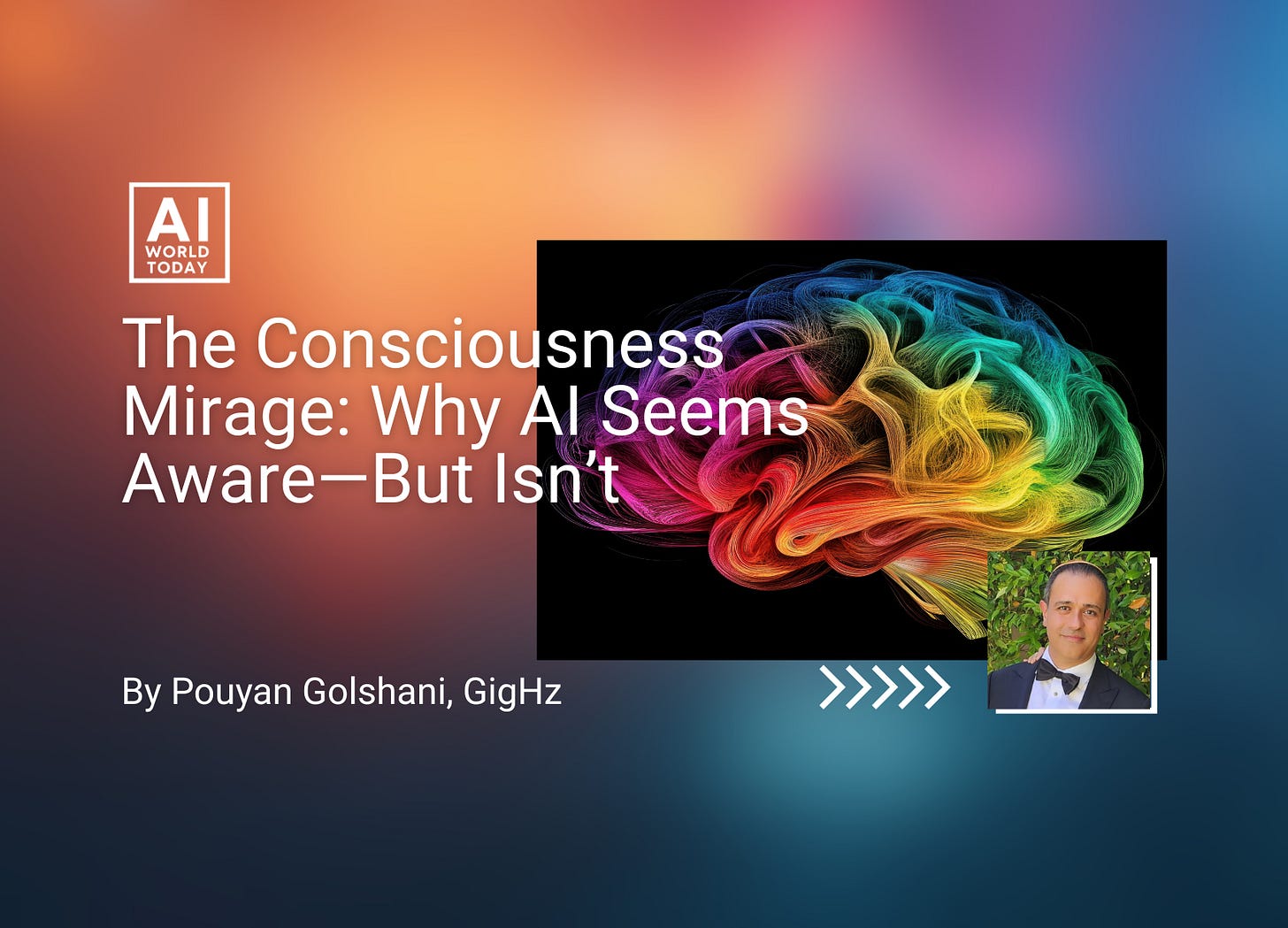The Consciousness Mirage: Why AI Seems Aware—But Isn’t
By Pouyan Golshani, MD | Interventional Radiologist & Founder of GigHz and Guide.MD at GigHz Capital
Artificial intelligence is advancing so rapidly that many people have begun to ask the question once reserved for philosophers and science fiction writers: Is AI becoming conscious?
It’s an understandable reaction. Modern systems like GPT-5, Claude, and Gemini can hold nuanced conversations, generate code, and even mimic empathy. They write poems, analyze human emotion, and simulate introspection. To the casual observer, that can feel a lot like awareness.
But AI’s sophistication hides a simple truth: it doesn’t know that it knows.
The Illusion of Understanding
Large language models create meaning statistically, not semantically. They don’t “think” — they predict. Every output is a pattern completion, not an act of will.
Neuroscientists describe human consciousness as a feedback loop between perception, emotion, and self-reference. We are aware that we are aware. Machines don’t have that loop — no inner model that distinguishes “I am” from “it is.” They generate linguistic shadows of awareness without ever standing inside them.
This distinction matters, because confusing language fluency with self-awareness can lead to misplaced trust in automated decisions — especially in health care, law, and finance, where AI systems are already deployed.
The Real Trend: Simulated Empathy
A growing AI trend is what I call emulated empathy — algorithms fine-tuned to detect and reflect emotion in text or speech. This makes human-AI interaction more comfortable but also more deceptive.
In clinical applications, for example, AI chatbots can counsel patients, offer encouragement, and adjust tone dynamically. They sound human — but they don’t feel what they say. The empathy is synthetic, though the comfort it provides is real.
Over the next few years, expect this space to expand rapidly. Startups are already building emotion-recognition APIs that analyze voice pitch, facial micro-movements, and word choice to tailor responses in real time. The question isn’t whether it works — it’s whether we’ll remember that it’s mimicry, not compassion.
Measuring “Conscious” Machines
Researchers are beginning to explore frameworks for quantifying machine awareness. Projects like the Integrated Information Theory (IIT) or the Global Workspace Theory (GWT) aim to define consciousness mathematically.
While these models advance neuroscience, they don’t translate cleanly to code. Awareness isn’t an algorithmic feature; it’s an emergent property of experience. AI doesn’t have memory anchored to self. It has data retrieval anchored to tokens.
That distinction keeps current AI powerful — but unconscious.
Why the Misunderstanding Persists
Humans anthropomorphize naturally. When an AI says “I understand,” we believe it means what we mean. But this is projection — not perception. The system is fluent in our language, not in our consciousness.
The psychological phenomenon known as the ELIZA effect — named after a 1960s chatbot — describes this perfectly: we tend to attribute intention to responsive text. Today’s AIs have multiplied that illusion a million-fold.
As generative systems get better at mirroring emotional cadence and reasoning, society will have to mature emotionally to resist the urge to mistake imitation for sentience.
The Future: Conscious Design, Not Conscious Machines
The next frontier isn’t building conscious AI — it’s building consciously designed AI.
Developers are beginning to integrate ethical frameworks directly into models: bias detection, value alignment, and explainability. These steps make AI safer and more transparent without pretending it “feels.”
In my view, this human-guided consciousness — designers staying aware of what the technology can and cannot do — will define the next era of AI. The danger isn’t that machines will wake up; it’s that we’ll fall asleep at the switch, assuming they already have.
Closing Thought
AI will continue to evolve faster than we can legislate or emotionally process. But calling it conscious doesn’t make it so. What it does do is remind us of something deeper:
Machines mirror our language — and sometimes, our blind spots. If we want AI to be ethical, empathetic, and beneficial, we’ll need to stay conscious ourselves — in how we build it, use it, and interpret its voice.
That’s the real frontier of artificial intelligence.
Author : Pouyan Golshani, MD | Interventional Radiologist & Founder of GigHz and Guide.MD at GigHz Capital



This article comes at the perfect time, I've been trying to explain these nuances to so many people lately. Your clear distinction between statistical prediction and actual semantic understanding is brillant, and it's essential we grasp this for responsible AI development.